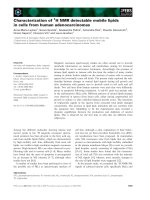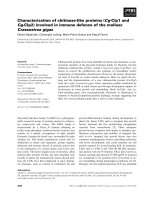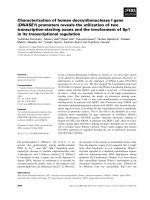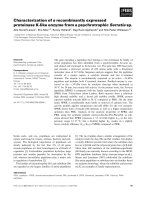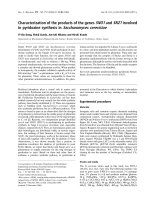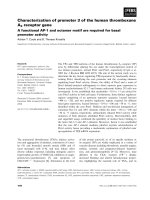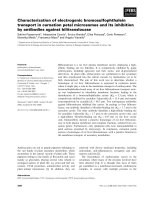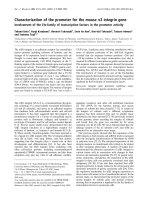Báo cáo khoa học: Characterization of D-amino-acid-containing excitatory conotoxins and redefinition of the I-conotoxin superfamily pot
Bạn đang xem bản rút gọn của tài liệu. Xem và tải ngay bản đầy đủ của tài liệu tại đây (477.37 KB, 11 trang )
Characterization of D-amino-acid-containing excitatory
conotoxins and redefinition of the I-conotoxin superfamily
Olga Buczek
1
, Doju Yoshikami
1
, Maren Watkins
2
, Grzegorz Bulaj
1
, Elsie C. Jimenez
1,3
and
Baldomero M. Olivera
1
1 Department of Biology and 2 Pathology, University of Utah, Salt Lake City, UT 84112, USA
3 Department of Physical Sciences, College of Science, University of the Philippines Baguio, Baguio City, Philippines
The traditional approach in biochemistry to studying
proteins is purification from the natural source; how-
ever, the access to genomic information has provided
a different, increasingly dominant methodology. The
technology for manipulating nucleic acids and expres-
sing polypeptides has advanced so rapidly that fewer
and fewer native proteins are being purified; instead,
the encoding genes are expressed in recombinant sys-
tems. This has become the standard approach used for
functionally characterizing gene products.
A potential liability in adopting the modern para-
digm is that functionally important post-translational
modifications may be overlooked. If the natural
gene product is post-translationally modified, but the
polypeptide expressed from a cloned sequence is not,
then the latter could be functionally deficient to vary-
ing extents. For this reason, in the genomic era, it is
increasingly important to reliably predict when and
where a particular post-translational modification may
occur. Some post-translational modifications are easily
predicted as they occur on highly specific amino-acid
sequences (for example, N-glycosylation or phosphory-
lation by various kinases). Even when no consensus
sequence to predict a post-translational modification
can be written down, if enough examples are charac-
terized, an accurate prediction of a post-translational
event can often be made; this is the situation with
regard to predicting signal sequences and where a
Keywords
conotoxin;
D-amino acid; excitatory peptides;
post-translational modification; repetitive
action potential
Correspondence
B. M. Olivera, Department of Biology,
University of Utah, 257 South 1400 East,
Salt Lake City, UT 84112, USA
Tel: +1 801 581 8370
Fax: +1 801 585 5010
E-mail:
(Received 25 April 2005, revised 15 June
2005, accepted 21 June 2005)
doi:10.1111/j.1742-4658.2005.04830.x
Post-translational isomerization of l-amino acids to d-amino acids is a
subtle modification, not detectable by standard techniques such as Edman
sequencing or MS. Accurate predictions require more sequences of modi-
fied polypeptides. A 46-amino-acid-long conotoxin, r11a, belonging to the
I-superfamily was previously shown to have a d-Phe residue at position 44.
In this report, we characterize two related peptides, r11b and r11c, with
d-Phe and d-Leu, respectively, at the homologous position. Electrophysio-
logical tests show that all three peptides induce repetitive activity in frog
motor nerve, and epimerization of the single amino acid at the third posi-
tion from the C-terminus attenuates the potency of r11a and r11b, but not
that of r11c. Furthermore, r11c (but neither r11a nor r11b) also acts on
skeletal muscle. We identified more cDNA clones encoding conopeptide
precursors with Cys patterns similar to r11a ⁄ b ⁄ c. Although the predicted
mature toxins have the same cysteine patterns, they belong to two different
gene superfamilies. A potential correlation between the identity of the gene
superfamily to which the I-conotoxin belongs and the presence or absence
of a d-amino acid in the primary sequence is discussed. The great diver-
sity of I-conopeptide sequences provides a rare opportunity for defining
parameters that may be important for this most stealthy of all post-trans-
lational modifications. Our results indicate that neither the chemical nature
of the side chain nor the precise vicinal sequence around the modified resi-
due seem to be critical, but there may be favored loci for isomerization to
a d-amino acid.
4178 FEBS Journal 272 (2005) 4178–4188 ª 2005 FEBS
signal peptidase will cleave; despite the lack of a rigidly
specified consensus sequence, enough data have been
collected to make the predictive programs based on
the existing data quite reliable.
One of the most subtle and difficult-to-detect post-
translational modifications is the epimerization of a
standard l-amino acid to its d-isomer. This is a parti-
cularly stealthy modification because it remains un-
detectable by standard proteomic methods such as
Edman sequencing or MS. Although post-translational
epimerization is a modification with which the larger
molecular biological community has not been parti-
cularly concerned, there is increasing evidence that its
occurrence is surprisingly widespread: it has been
found in gene products from very divergent phyla,
including chordates, arthropods and molluscs. In verte-
brates, this post-translational modification has been
discovered in amphibian as well as mammalian systems
[1–6]. Additional data on post-translational epimeriza-
tion are therefore highly desirable; the only reliable
predictions for when d-amino acid epimerization may
occur are in two small families of highly specialized
peptides, notably an opiate peptide family from frog
skin (which are all seven amino acids long and highly
homologous to each other), and the contryphan family
of peptides from Conus (which are eight amino acids
long with highly conserved sequence motifs).
Apart from the frog skin opiate peptides and the
contryphans, other gene products that have been char-
acterized with d-amino acids are quite a heterogeneous
assemblage. Despite this, it has been noted that there
are preferential loci for modification, i.e. either on the
second amino acid from the N-terminus, or on the
third amino acid from the C-terminus. However, there
has not been an opportunity to further define in what
sequence contexts epimerization is likely to occur.
The recent discovery of a functionally important
d-phenylalanine residue in a peptide of the I-gene
superfamily of conotoxins provides a potentially much
more diverse sequence database in which to explore
the factors required for epimerization of an l-amino
acid to a d-amino acid to occur. The I-superfamily
peptides have eight cysteine residues in the primary
sequence, with the characteristic pattern –C–C–CC–
CC–C–C–, and conotoxins belonging to this family are
larger than those belonging to other Conus peptide
families. I-superfamily conotoxins have been found
broadly over many Conus species; although all have
the characteristic Cys pattern, these toxins have extre-
mely diverse amino-acid sequences [8–11]. Many
appear to be excitatory (and in certain cases, have
been shown to target specific potassium channels);
their diversity provides a framework for predicting
which peptides have a d-amino acid, and which do
not.
The I-superfamily peptide previously shown to have
a d-phenylalanine residue [7], r11a, is 46 amino acids
in length with the d-Phe residue at position 44. In this
report, we characterize two peptides, r11b and r11c,
purified from venom, that show various extents of
sequence homology to r11a; a comparison of the three
sequences is shown in Table 1 (the position of the con-
firmed d-phenylalanine residue in r11a is underlined).
There is a notable difference in the sequence diver-
gence from r11a at the C-terminal 12 amino acids
(boxed residues in Table 1): the sequences of r11a and
r11b are almost identical (with a single conservative
substitution), whereas the sequences of r11a and r11c
differ in seven out of 12 amino-acid positions, inclu-
ding the amino acid Phe44 in r11a which is racemized.
Thus, if there were a stringent sequence determinant
for post-translational epimerization in the vicinity of
the residue to be modified, or if the enzyme were
highly specific for the phenyl side chain, it might be
predicted that the native r11b would have a d-phenyl-
alanine at the same locus as r11a, and r11c might have
an l-leucine analog at the homologous position.
To test these predictions experimentally, we carried
out the chemical synthesis of both l and d forms of
r11b and r11c to compare these with the native mater-
ial. All forms have also been functionally character-
ized. In addition, we carried out a further molecular
definition of the I-superfamily. In contrast with all
other conotoxin gene superfamilies, we found that the
Table 1. Amino-acid sequences of I-conotoxins with a D-amino acid near the C-terminus. O,4-trans-hydroxyproline; F, D-phenylalanine; ^,
C-terminal free acid. Peptide r11c is presumably synthesized with a C-terminal arginine as determined from a cDNA clone [8], but the argin-
ine is cleaved by a carboxypeptidase (also, Table 3).
Peptide Sequence
10 20 30 40
r11a GOSF
CKADEKOCEYHADCCNCCLSGICAOSTNWILPGCSTSSFFKI^
r11b GOSF
CKANGKOC SYHADCCNCCLSGIC KOSTN V ILPGCSTSSFF RI^
r11c GOSF
CKADEKOC KYHADCCNCCLGGICKOSTSWI
G
CSTNVFLT
^
O. Buczek et al. Defining the I-conotoxin superfamily
FEBS Journal 272 (2005) 4178–4188 ª 2005 FEBS 4179
same Cys pattern is apparently shared by two entirely
distinct gene superfamilies. Thus, what was previously
referred to as the I-conotoxin superfamily should now
be divided; a potential connection between the identity
of the gene superfamily to which the conotoxin
belongs, and the presence or absence of a d-amino
acid in the peptide will be discussed.
Results
Purification and synthesis of I-superfamily
conotoxins
The excitatory peptides r11b and r11c were purified
from the venom of the fish-hunting species Conus radi-
atus as described previously [8], but with some modifi-
cation for the purification of r11b. As shown in Fig. 1,
r11b was purified to homogeneity after four RP-HPLC
runs.
Based on the sequences of the native peptides
(Table 1), conotoxins r11b and r11c were chemically
synthesized on a solid support using a standard Fmoc
protocol. Two versions of both peptides were pro-
duced, one with all l-amino acids and the second with
a single d-amino acid at the locus homologous to
d-Phe44 of r11a, i.e. d-Phe at position 44 of r11b and
d-Leu at position 42 of r11c. Both variants of the tox-
ins were folded in the presence of reduced and oxidized
glutathione with a yield of 70%, and purified to homo-
geneity by RP-HPLC. The identities of the peptides
were confirmed by MALDI MS, and the molecular
masses of the synthetic toxins ([l-Phe44]r11b,
4857.8 Da; [d-Phe44]r11b, 4858.7 Da; [l-Leu42]r11c,
4629.0 Da; [d-Leu42]r11c, 4629.1 Da) were within an
atomic mass unit of those calculated from amino-acid
sequences.
D-Amino acids are present in native r11b and r11c
HPLC co-injections of each of the two synthetic
variants of r11c conotoxin, [l-Leu42]r11c and
[d-Leu42]r11c with the natural form were performed.
As illustrated in Fig. 2, only the d-Leu42-containing
variant coeluted with the natural peptide. As previ-
ously shown, r11a, another I-conotoxin [7,8], has a
d-Phe at position 44 of the 46-residue peptide; cono-
toxins r11a and r11b have high sequence homology
(Table 1), thereby leading to the strong prediction that
d-Phe is located at position 44 in r11b. Indeed, both
natural and synthetic r11b with d-Phe44 have an iden-
tical elution time, which differs from that of the all-
l isomer by about 1.0 min under the same HPLC
Fig. 1. Purification of conotoxin r11b. (A)
Fractionation of crude venom extract using
a Vydac C
18
semipreparative column eluted
with a gradient of 0–60% solvent B
90
over
120 min at a flow rate of 5 mLÆmin
)1
.(B)
Elution of the bioactive fraction marked by
an arrow in (A) using a C
18
analytical column
and a gradient of 30–40% solvent B
90
over
40 min. (C) Further purification of the bio-
active fraction marked by an arrow in (B)
with a gradient of 25–55% solvent B
90
over
30 min. (D) Pure r11b was obtained after
elution of the fraction marked by an arrow
in (C) with a gradient of 25–52% solvent B
90
over 27 min. For chromatograms B–D, the
flow rate was 1 mLÆmin
)1
.
Defining the I-conotoxin superfamily O. Buczek et al.
4180 FEBS Journal 272 (2005) 4178–4188 ª 2005 FEBS
conditions (Fig. 3). Thus, the correct amino-acid
sequences of conotoxins r11b and r11c have d-Phe and
d-Leu at positions 44 and 42, respectively. Henceforth,
we will refer to the d version of the peptides simply as
r11b and r11c, and the all-l versions as [l-Phe44]r11b
and [l-Leu42]r11c.
Increased biological potency of
D-amino-acid-
containing peptides
A whole animal behavioral assay with 15-day-old mice
was used to assay r11b, r11c and their l isomers. In
the case of r11b, a fivefold difference was observed in
potencies of the d-Phe44 and l-Phe44 forms. The esti-
mate is based on comparison of the threshold dose
that induced hyperactivity symptoms (tail raising,
rapid walking, circular motion, sensitivity to touch),
which was 20 pmol for r11b and 100 pmol for
[l-Phe44]r11b. An approximately fivefold difference in
potency was likewise observed between the d-Leu42
and l-Leu42 forms of r11c. Similarly, this estimate is
based on a comparison of the dose at which hyper-
activity symptoms appeared (tail raising, convulsions),
which was 20 pmol for the r11c and 100 pmol for the
[l-Leu42]r11c.
The synthetic forms of peptides r11b and r11c were
also tested on a frog nerve–muscle preparation as
previously described [7,8]. The results are shown in
Figs 4 and 5. Both r11c and [l-Leu42]r11c were active
in inducing repetitive activity in this preparation. As
a measure of potency, the on rates of the peptides
were compared by observing the time it took for
repetitive nerve activity to be manifested (the ‘induc-
tion time’). When tested at a concentration of
100 nm, both l-Leu42 and d-Leu42 forms of r11c
had induction times of 2 min (Fig. 4). On the other
hand, the induction time for 100 nm r11b was longer,
4 min (not illustrated, see legend of Fig. 4 for sta-
tistics). This is similar to the induction time pre-
viously reported for 100 nm r11a [7]. In contrast with
Fig. 2. HPLC analysis. Top panel, natural r11c (r11c N); middle
panel, a mixture of two synthetic variants, r11c (r11c S) and
[
L-Leu42]r11c; bottom panel, a mixture of natural and synthetic
r11c (r11c N and r11c S). Elutions were carried out using a C
18
ana-
lytical column at 45 °C with a gradient of 30–50% B over 20 min at
a flow rate of 1 mLÆmin
)1
.
Fig. 3. HPLC analysis. Top panel, natural r11b (r11b N); bottom
panel, a mixture of two synthetic variants, r11b (r11b S) and
[
L-Phe44]r11b. Elutions were carried out using a C
18
analytical col-
umn at 45 °C with gradient of 30–50% B over 20 min at flow rate
of 1 mLÆmin
)1
.
O. Buczek et al. Defining the I-conotoxin superfamily
FEBS Journal 272 (2005) 4178–4188 ª 2005 FEBS 4181
its d-counterpart, [l-Phe44]r11b did not induce repeti-
tive activity even at a concentration of 10 lm (not
illustrated). This is consistent with the observation
that [l-Phe44]r11a is also inactive on the frog prepar-
ation [7].
Figure 4 also shows that r11c can induce repetitive
activity not only in nerve, but also in muscle. Figure 5
shows that [l-Leu42]r11c, like its d-Leu counterpart,
can induce repetitive activity in muscle. On the other
hand, r11b was able to induce repetitive activity in
nerve, but not muscle per se (Fig. 5). To further exam-
ine the peptides’ activity, the muscle was directly sti-
mulated, and the participation of nerve activity was
avoided by using d-tubocurare to block any synaptic
activity as described in Experimental Procedures. Fur-
thermore, the application of peptide was confined to
one end of the muscle, where there are few, if any,
neuromuscular synapses. Figure 6 shows that both
l-Leu42 and d-Leu42 forms of r11c were about equi-
potent in inducing repetitive action potentials under
these conditions. In contrast, neither r11a nor r11b
were active in this assay when tested with concentra-
tions up to 1 lm (not illustrated). The differences in
the effects of r11a, r11b, r11c and their l isoforms are
summarized in Table 2.
cDNA cloning and identification of I-superfamily
conotoxins
We previously identified cDNA clones, R11.6, R11.14
and R11.4, encoding the I-superfamily conotoxins
r11a, r11b and r11c, respectively [8]; this report des-
cribed the initial characterization of the I-conotoxin
superfamily. Other cDNA clones belonging to the
I-superfamily were identified from both C. radiatus
and other species. Homologous sequences including
Fig. 4. The synthetic D-Leu42 and L-Leu42 forms of r11c have comparable activities on the frog nerve–muscle preparation. Responses to
nerve stimulation were obtained simultaneously from muscle (lower panels) and nerve (upper panels) every 30 s, except during solution
exchange (Experimental procedures). Successive responses are shown in each panel from bottom to top, before (lowest trace in each panel)
and during (remaining traces) exposure to 100 n
M of [L-Leu42]r11c (panels A1 and A2) or r11c (B1 and B2). In each panel, the gap between
the lowest trace and the one immediately above it reflects the time during which peptide was being applied, and no recordings were made.
Vertical and horizontal units are mV and ms, respectively (1 mV vertical displacement of traces corresponds to an elapsed time of 30 min).
To show the repetitive action potentials clearly, a y-axis range was used that truncated the evoked compound action potential. The latter is
seen in each panel almost immediately after the nerve stimulus, which was applied 20 ms after the start of each trace. The first nerve trace
to show repetitive activity occurred after about 1.5 min for both peptides. This ‘induction time’ for repetitive activity in the nerve with
[
L-Leu42]r11c was 1.9 ± 0.2 min (mean ± SD, N ¼ 6), and with r11c it was 1.6 ± 0.2 (N ¼ 5). The induction time with r11b was significantly
longer (not illustrated), 3.8 ± 2 min (N ¼ 3). Note that, with r11c, repetitive activity in the muscle can be seen after peptide application (panel
B2), without any repetitive activity in the nerve (panel B1); this is consistent with r11c having a target in muscle, as well as in nerve (Fig. 6).
The effects of these peptides were reversible after washout (not illustrated).
Defining the I-conotoxin superfamily O. Buczek et al.
4182 FEBS Journal 272 (2005) 4178–4188 ª 2005 FEBS
those from Conus figulinus and Conus betulinus, which
are worm-hunting species, and Conus episcopatus,a
mollusc-hunting species, are shown in Table 3. In
Group A, all peptides have the consensus pattern –
CX
6
CX
5
CCXCCX
4
CX
8)10
C–. The high sequence
homology and the confirmed presence of a d-amino
Fig. 5. r11b Acts on nerve, but [L-Leu42]r11c acts on both nerve and muscle. Stimulation and recording were as in Fig. 4. (A) In 100 nM
r11b, each action potential in the muscle recording (lower trace) has a corresponding action potential that just precedes it in the nerve
recording (upper trace), indicating that this peptide’s target is in nerve, but not muscle. (B) In contrast, in 100 n
M [L-Leu42]r11c, there are
many events in the muscle recording without a corresponding event in the nerve recording, indicating that this peptide has targets in both
nerve and muscle. Note the spontaneous activity in muscle (and single event in nerve) preceding the stimulus, which was applied at 20 ms
from the start of each trace. Repetitive events in muscle, without corresponding events in nerve, were also induced by r11c (Fig. 4B1,2).
The effects of these peptides were reversible after the washout (not illustrated). Repetitive activity could not be elicited in either nerve or
muscle with [
L-Phe44]r11b, even at a concentration of 10 lM (not illustrated).
Fig. 6. [L-Leu42]r11c and r11c have comparable effects on directly stimulated muscle. Action potentials were evoked by directly stimulating
one end of the muscle every 30 s while recording from the other end, as described in Experimental procedures. Recordings are presented
as in Fig. 4. Thus, the lowest trace in each panel represents the control response, and all others are those during progressive exposure to
100 n
ML-Leu42 peptide (A) or D-Leu42 r11c (B). D-Tubocurare (10 lM), a postsynaptic acetylcholine receptor blocker, was present in both
control and peptide solutions to block any possible, although unlikely, contributions of synaptic activity. Exposure to peptide was confined to
one end of the muscle, opposite the end that was electrically stimulated. A 1-mV vertical displacement of the traces represents an elapsed
time of 30 s. The muscle was stimulated 20 ms after the start of each trace, and after a latency of 5 ms, a compound action potential
was observed. After exposure to the peptide, events are seen with a polarity opposite that of the evoked-compound action potential, indica-
ting that these events were action potentials propagating in the opposite direction, as would be expected if they were generated at the end
of the muscle to which toxin had been applied. It is evident that both peptides induced repetitive firing within 2 min of peptide exposure.
These results demonstrate that both peptides have muscle targets and are about equally potent. The actions of both peptides were reversed
after washout (not illustrated).
O. Buczek et al. Defining the I-conotoxin superfamily
FEBS Journal 272 (2005) 4178–4188 ª 2005 FEBS 4183
acid in peptides r11a, r11b and r11c strongly suggest
that other peptides belonging to the first group in the
table undergo post-translational isomerization at the
third amino acid from the C-terminus; these include
clones Fi11.1 from a worm-hunting Conus species and
M11.1 and S11.2 from fish-hunting Conus species.
A second group of I-conotoxin clones (Group B in
Table 3) was highly homologous to Group A in their
precursor sequences. However, all of these peptides
have a slightly different consensus pattern –CX
6
CX
5
CCX
3
CCX
4
CX
6
C–, and the presence of a d-amino
acid at the third position from the C-terminus is
impossible or improbable. Note that either a Gly resi-
due or a Cys involved in a disulfide bond is present at
that locus.
Surprisingly, we have also identified I-conotoxin
family clone sequences (Group C in Table 3) that have
signal sequences completely unrelated to those of
Groups A and B, and which lack the canonical pro-
peptide region that has been a hallmark of all conotox-
in precursors. This group includes cDNA clones of
Em11.10, Fi11.11, Ep11.12 and Sx11.2 identified from
Conus emaciatus, Conus figulinus, Conus episcopatus
and Conus striolatus, respectively. All the mature pep-
tides belonging to this group have the following consen-
sus cysteine pattern: –CX
6
CX
5
CCX
3
CCX
2)3
CX
3
C–.
Examples of complete precursor sequences from all
three groups are shown in Table 4.
Table 2. Activities of I-conopeptides in inducing repetitive action
potentials in two target tissues from frog. A plus sign indicates that
the peptide induces repetitive action potentials within 5 min of its
application at a concentration of 100 n
M (e.g. Fig. 4).
Peptide Motor nerve Skeletal muscle Reference
r11a
D-Phe44 + – [7]
L-Phe44 – – [7]
r11b
D-Phe44 + – This work
L-Phe44 – – This work
r11c
D-Leu42 + + This work
L-Leu42 + + This work
Table 3. Amino-acid sequences of I-superfamily peptides determined from cDNA clones. Peptides with the following precursor consensus
sequence: MKLCVTFLLVLMILPSVTG ⁄ EKSSERTLSGALLRGVKRR; defined as the I
1
superfamily. Peptides with the following
precursor consensus sequence: MMFRVTSVGCFLLVIVFLNLVVLTDA; defined as the I
2
superfamily. O, 4-trans-hydroxyproline; F, D-phenyl-
alanine; L,
D-leucine; ^, C-terminal free acid. c, c-carboxyglutamate; *, C-terminal amidation. The underlined parts of sequences are
presumed to be post-translationally cleaved by carboxypeptidase.
Conus species Clone ⁄ peptide Sequence Reference
Group I
A (presence of
D-amino acid either demonstrated or strongly predicted)
C. radiatus R11.6 ⁄ r11a GPSF
CKADEKPCEYHADCCNCCLSGICAPSTNWILPGCSTSSFFKI
GOSF
CKADEKOCEYHADCCNCCLSGICAOSTNWILPGCSTSSFFKI^
[8]
C. radiatus R11.14 ⁄ r11b GPSF
CKANGKPCSYHADCCNCCLSGICKPSTNVILPGCSTSSFFRI
GOSF
CKANGKOCSYHADCCNCCLSGICKOSTNVILPGCSTSSFFRI^
[8]
C. radiatus R11.4 ⁄ r11c GPSF
CKADEKPCKYHADCCNCCLGGICKPSTSWI GCSTNVFLTR
GOSF
CKADEKOCKYHADCCNCCLGGICKOSTSWI GCSTNVFLT^
[8]
C. figulinus Fi11.1a GHVS
CGKDGRACDYHADCCNCCLGGICKPSTSWI GCSTNVFLTR This work
C. magus M11.1a GAVP
CGKDGRQCRNHADCCNCCPIGTCAPSTNWILPGCSTGQFMTR This work
C. striatus S11.2a G
CKKDRKPCSYQADCCNCCPIGTCAPSTNWILPGCSTGPFMAR This work
B (presence of
D-amino acid unlikely)
C. radiatus R11.3 GPR
CWVGRVHCTYHKDCCPSVCCFKGRCKPQSWGCWSGPT [8]
C. betulinus Bt11.1 M
CLSLGQRCERHSNCCGYLCCFYDKCVVTAIGCGHY This work
C. episcopatus Ep11.1 GDWGM
CSGIGQGCGQDSNCCGDMCCYGQICAMTFAACGP This work
Group II
C
C. betulinus BtX ⁄ BtX
CRAEGTYCENDSQCCLNECCWGGCGHPCRHPGKRSKLQEFFRQR
CRAgGTYCgNDSQCCLNgCCWGGCGHOCRHP*
[10]
C. virgo ViTx ⁄ ViTx SR
CFPPGIYCTSYLPCCWGICCSTCRNVCHLRIGKRATFQE
SR
CFPPGIYCTSYLPCCWGICCSTCRNVCHLRIGK^
[9]
C. emaciatus Em11.10
CFPPGIYCTPYLPCCWGICCGTCRNVCHLRIGKRATFQE This work
C. figulinus Fi11.11
CHHEGLPCTSGDGCCGMECCGGVCSSHCGNGRRRQVPLKSFGQR This work
C. episcopatus Ep11.12
CLSEGSPCSMSGSCCHKSCCRSTCTFPCLIPGKRAKLREFFRQR This work
C. striolatus Sx11.2
CRAEGTYCENDSQCCLNECCWGGCGHPCRHPGKRSKLQEFFRQR This work
Defining the I-conotoxin superfamily O. Buczek et al.
4184 FEBS Journal 272 (2005) 4178–4188 ª 2005 FEBS
Discussion
The presence of a functionally important d-Phe residue
in position 44 of the I-conotoxin superfamily peptide
r11a was established previously [7]. In this work, we
determined whether other I-conotoxin superfamily pep-
tides have a d-amino acid at the homologous locus,
specifically, r11b and r11c (which differ from r11a at
6 and 11 positions, respectively). Because of the con-
siderable sequence similarity in the C-termini of r11a
and r11b, we had predicted that r11b would have a
d-Phe residue at the position homologous to d-Phe44
in r11a. In the case of r11c, however, seven out of 12
amino acids at the C-terminus of r11a are not con-
served, including the amino acid to be modified (Phe
in the case of r11a compared with Leu in the case of
r11c). Furthermore, in the mature toxin purified from
venom, the homologous Leu residue is the penultimate
residue, and not three amino acids from the C-termi-
nus, the previously postulated favored locus for modi-
fication. Thus, we could not confidently predict
whether or not the homologous Leu residue would be
post-translationally modified. The experimental data
presented above unequivocally establish that both
native r11b and r11c peptides purified from venom do
indeed have a d-amino acid at the position homo-
logous to d-Phe44 in r11a.
A functional comparison of these I-superfamily
conotoxins was also carried out. It is clear that in the
amphibian nerve–muscle preparation used, r11c has
different molecular targeting specificity from r11a and
r11b, as it elicits repetitive action potentials in directly
stimulated muscle, whereas the other two peptides do
not (Table 2). For r11a and r11b, converting the
d-amino acid into the corresponding l isomer resulted
in a complete loss of potency in eliciting repetitive
action potentials in motor nerve. An additional note-
worthy feature of r11c is that, unexpectedly, the
[l-Leu42]r11c analog was just as active as the d-Leu-
containing peptide.
The fact that the epimerized Leu residue is only two
amino acids from the C-terminus of the mature toxin
can be rationalized. The cDNA clone that encodes
r11c, R11.4 (Table 3), has an additional amino acid at
the C-terminus, an Arg residue; presumably, this was
cleaved off by a carboxypeptidase. Thus, the discovery
of a d-Leu residue in the sequence of r11c is consistent
with the postulate that the third amino acid from the
C-terminus is preferentially modified if the epimeriza-
tion took place before the carboxypeptidase digestion.
Chemical synthesis has been reported for only one
other I-conotoxin, the K channel inhibitor from Conus
virgo, ViTx [9]. BtX, purified from the venom of Conus
betulinus, has been characterized as a specific BK chan-
nel modulator [10]. These peptides were reported to be
biologically active with no indication that a d-amino
acid was present (for sequences, see Table 3). The sec-
ond substantive conclusion from the data presented
above is that, surprisingly, the peptides that we charac-
terized in this work belong to a gene superfamily differ-
ent from the one to which ViTx and BtX belong. As, in
all previous studies, the Cys pattern of a conotoxin is
strongly predictive of the gene superfamily to which the
particular peptide belongs, the discovery that I-cono-
Table 4. Complete precursor sequences of I-superfamily peptides presented in Table 3. Conus species: R, C. radiatus; Ep, C. episcopatus;
Bt, C. betulinus;Sx,C. striolatus.
a
For reference see [10]; all other complete precursor sequences came from the present report.
O. Buczek et al. Defining the I-conotoxin superfamily
FEBS Journal 272 (2005) 4178–4188 ª 2005 FEBS 4185
toxins really comprise two different gene superfamilies
was unexpected. The diagnostic difference between the
two superfamilies is that they have completely different
signal sequences (Table 3); we will refer to these as the
I
1
superfamily (Group A and B in Table 3, including
r11a, r11b and r11c) and the I
2
superfamily (Group C
in Table 3, including ViTx and BtX). A noteworthy fea-
ture of the I
2
superfamily is that it lacks a propeptide
region between signal sequence and mature toxin, dif-
fering from all other conotoxin superfamilies in this
respect. As shown in Table 3, and as previously noted
by Kauferstein et al. [11], another characteristic of the
I
2
superfamily is that a small region at the C-terminus
is proteolytically excised.
Thus, all of the d-amino-acid-containing peptides
characterized above belong to the I
1
superfamily. Pre-
vious work on a post-translational modification of
conotoxins, the c-carboxylation of glutamate residues,
has indicated that there may be a recognition signal
sequence that serves as an anchor site for the modifica-
tion enzyme [12]. Thus, one possible scenario that
must be considered in light of the results presented
above is that, as in the previous work on Conus pep-
tide c-carboxylation, the isomerase that acts on newly
translated precursors of r11a, r11b and r11c might
have a recognition sequence present in I
1
family pep-
tides; once anchored to the recognition sequence, the
enzyme then acts on the preferred locus for modifica-
tion, three amino acids from the C-terminus. However,
the I
2
superfamily may lack a recognition signal, and,
consequently, the same pattern of conversion of
l-amino acids into d-amino acids might not be opera-
tive for peptide precursors in that superfamily.
A key insight from this work, given the considerable
divergence in sequence at the C-terminus, is that it
appears that the enzymatic machinery that post-trans-
lationally modifies the l- amino acid to the d-amino
acid does not stringently recognize a long vicinal
sequence around the residue to be modified, nor is it
specific for a particular amino-acid side chain in the
residue epimerized. The data do not preclude the pre-
sence of a sequence-recognition motif at the C-terminal
region; however, the considerable divergence in
sequence clearly eliminates a majority of amino acids
in the vicinity of the modified Phe or Leu residue as
being essential for recognition.
It is somewhat exceptional to have in hand both
the native peptide confirmed to have a d-amino acid,
and synthetic or expressed versions with both
l-amino acids and d-amino acids at the correct locus
in order to predict when and where d-amino acids
may be found post-translationally in polypeptide
chains. The I-conotoxins are a large and diverse
group, and they provide one of the rare opportunities
for examining and defining the parameters that may
be important for this most stealthy of all post-trans-
lational modifications.
Experimental procedures
Purification of conotoxins r11b and r11c from
C. radiatus venom
Crude venom extract was prepared as described previously
[13]. The extract was loaded on to a Vydac C
18
semiprepar-
ative HPLC column and eluted at 5 mLÆmin
)1
with a gradi-
ent of solvent A (0.1% trifluoroacetic acid) and solvent B
90
(0.085% trifluoroacetic acid in 90% acetonitrile). Peptides
r11b and r11c were further purified on a Vydac C
18
analy-
tical column at a flow rate of 1 mLÆmin
)1
, as previously [8],
with the modifications for peptide r11b indicated in the
legend to Fig. 1.
Mass spectrometry
MALDI mass spectra were obtained using a Bruker
REFLEX time-of-flight mass spectrometer (Bruker Dalton-
ics, Billerica, MA, USA) fitted with gridless reflectron, an
N
2
laser and a 100 MHz digitizer, courtesy of the Salk
Institute for Biological Studies (La Jolla, CA, USA). Alter-
natively, MALDI mass spectra were obtained through the
Mass Spectrometry and Proteomic Core Facility of the
University of Utah.
Peptide synthesis
Peptides were synthesized on solid support by an auto-
mated peptide synthesizer using N-Fmoc-protected amino
acids, 2-(2-N-benzotriazol-1-yl)-1,1,3,3-tetramethyluronium
hexafluorophosphate and N,N-di-isopropylethylamine,
courtesy of Dr Robert Schackmann of the DNA ⁄ Peptide
Facility, University of Utah. All cysteine residues were tri-
tyl-protected. The coupling time was 1 h. Peptide clea-
vage ⁄ deprotection was accomplished with reagent K
(82.5% trifluoroacetic acid ⁄ 5% phenol ⁄ 5% water ⁄ 5% thio-
anisole ⁄ 2.5% ethane-1,2-dithiol) for 2 h at room tempera-
ture. Soluble crude peptides were precipitated with cold
methyl-t-butyl ether and centrifuged. The pellet was washed
with methyl-t-butyl ether, centrifuged again, then dissolved
in 25% acetonitrile in 0.1% trifluoroacetic acid and lyophi-
lized. The linear peptides were purified on a Vydac C
18
semipreparative HPLC column.
Oxidative folding
Oxidative folding of peptides was carried out with 0.1 m
Tris ⁄ HCl, pH 8.7, containing 1 mm EDTA, 1 mm oxidized
Defining the I-conotoxin superfamily O. Buczek et al.
4186 FEBS Journal 272 (2005) 4178–4188 ª 2005 FEBS
glutathione (GSSG) and 1 mm reduced glutathione (GSH)
at room temperature for 3 h. The reaction was initiated by
adding the linear synthetic peptide to a final concentration
of 20 lm, then quenched by adding formic acid to a final
concentration of 8%. The oxidized form was purified on a
Vydac C
18
HPLC column with a linear gradient 15–60%
solvent B (0.1% trifluoroacetic acid in 90% acetonitrile) for
40 min.
Bioassay
Conotoxins were dissolved in normal saline solution. Swiss
Webster mice (15 days old) were injected intracranially with
20 lL conotoxin solution using a 29-gauge insulin syringe.
Control animals were similarly injected with normal saline
solution only. Proper animal care and use protocols were fol-
lowed in accordance with the guidelines set by the University
of Utah Institutional Animal Care and Use Committee.
Electrophysiology
The cutaneus pectoris muscle preparation of Rana pipiens
was used as previously described [8]. Briefly, the record-
ing ⁄ stimulating chamber was made of Sylgard (Dow
Corning, Midland, MI, USA), and consisted of a rectangu-
lar trough ( 1mm· 15 mm · 4 mm deep) and an adja-
cent set of four abutting cylindrical wells (4 mm
diameter · 4 mm deep), with the well furthest from the
trough designated as well 1 and that closest as well 4. Each
compartment was separated from the adjacent one by
1 mm. A mini-muscle preparation [14] was pinned in the
trough, and the attached motor nerve was draped into the
adjacent wells, with the proximal end of the nerve in well
1. Portions of the nerve overlying the partitions were cov-
ered with vaseline. A pair of electrodes in wells 1 and 2
were used to stimulate the motor nerve. Well 2 also con-
tained a ground electrode. Pulses, 0.1 ms in duration, 6 V
in amplitude and applied through a stimulation isolation
unit, were used to evoke action potentials in the nerve at a
frequency of 2 min
)1
. Activity of the nerve was recorded
with a pair of electrodes located in wells 3 and 4. At the
same time, the activity of the muscle was recorded with a
pair of electrodes: one electrode was located in the middle,
and the other at one end, of the trough. Each pair of
recording electrodes was connected to a differential A ⁄ C
amplifier, and the signal bandpass-filtered (1 Hz to 3 kHz)
and digitized at a sampling frequency of 10 kHz. Home-
made software programmed in labview (National Instru-
ments, Austin, TX, USA) was used for data acquisition.
All electrodes were 0.01 inch diameter stainless-steel wires.
Solutions in all compartments were static and refreshed
periodically by manual replacement. Peptides were dis-
solved in frog Ringer’s containing 0.1 mgÆmL
)1
BSA. To
apply peptide, the fluid in the muscle-containing trough
was removed and replaced with the peptide solution. The
process took about 1.5 min, and accounts for the gap in
the records shown in Fig. 4. Recordings were performed at
room temperature ( 21 °C).
In experiments involving direct stimulation of the muscle,
instead of placing the muscle in the trough, the muscle was
denervated and stretched over all four wells, with one end
pinned in well 1 and the other end in well 4. Segments of
muscle in wells 2 and 3 were kept submerged by a hold-
down pin protruding horizontally from the wall of each
well and overlying the muscle. Exposed portions of the
muscle atop partitions were covered with vaseline, which
minimized tissue desiccation and also served as a barrier
that prevented fluid exchange between adjacent wells. Sti-
mulating electrodes were located in wells 1 and 2, and a
ground electrode in well 2. Recording electrodes were
located in wells 3 and 4. Peptide was added by exchange of
the fluid contents of well 4. To eliminate any contribution
from synaptic activity, well 4 contained 10 lmd-tubocurare
at all times to block postsynaptic acetylcholine receptors.
Stimulation and recording parameters were as described in
the previous paragraph.
Cloning and sequencing
Cloning and sequencing of cDNAs encoding I-conotoxins
cDNAs were prepared by reverse transcription of RNAs
isolated from Conus venom ducts as previously described
[15]. cDNA from each species was used as a template for
PCR with oligonucleotides corresponding to either the
conserved 5¢ UTR and 3¢ UTR sequences of prepropep-
tides for peptides I
1
, or the conserved signal sequence
and 3¢ UTR sequence of prepropeptides for peptides I
2
.
The resulting PCR products were purified using the High
Pure PCR Product Purification Kit (Roche Diagnostics,
Indianapolis, IN, USA) following the manufacturer’s sug-
gested protocol. The eluted DNA fragments were
annealed to pAMP1 vector, and the resulting products
transformed into competent DH5a cells, using the Clone-
Amp pAMP System for Rapid Cloning of Amplification
Products (Life Technologies ⁄ Gibco BRL, Grand Island,
NY, USA) following the manufacturer’s suggested proto-
cols. The nucleic acid sequences of the resulting toxin-
encoding clones were determined according to the stand-
ard protocol for automated sequencing.
Acknowledgements
This work was supported by Program Project GM
48677 from the National Institutes of Health.
References
1 Monteccuchi PC, de Castiglione R, Piani S, Gozzini L
& Erspamer V (1981) Amino acid composition and
O. Buczek et al. Defining the I-conotoxin superfamily
FEBS Journal 272 (2005) 4178–4188 ª 2005 FEBS 4187
sequence of dermorphin, a novel opiate-like peptide
from the skin of Phyllomedusa sauvagei. Int J Peptide
Protein Res 17, 275–283.
2 Kreil G, Barra D, Simmaco M, Espamer V, Falconieri-
Erspamer G, Negri L, Severini C, Corsi R & Melchiorri
P (1989) Deltorphin, a novel amphibian skin peptide
with high selectivity and affinity for d opioid receptors.
Eur J Pharmacol 162, 123–128.
3 Mor A, Deltour A, Sagan S, Amiche M, Pradelles P,
Rossier J & Nicholas P (1989) Isolation of dermenke-
phalin from amphibian skin, a high-affinity d-selective
opioid heptapeptide containing a d-amino acid residue.
FEBS Lett 255, 269–274.
4 de Plater GM, Martin RL & Milburn PJ (1998) A
C-type natriuretic peptide from the venom of the platy-
pus (Ornithorhynchus anatinus): structure and pharma-
cology. Comp Biochem Physiol C Pharmacol Toxicol
Endocrinol 120, 99–110.
5 Torres AM, Menz I, Alewood PF, Bansal P, Lahnstein
J, Gallagher CH & Kuchel PW (2002) D-Amino acid
residue in the C-type natriuretic peptide from the venom
of the mammal, Ornithorhynchus anatinus, the Austra-
lian platypus. FEBS Lett 524, 172–176.
6 Kreil G (1997) D-Amino acids in animal peptides. Annu
Rev Biochem 66, 337–345.
7 Buczek O, Yoshikami D, Bulaj G, Jimenez EC &
Olivera BM (2005) Posttranslational amino acid
isomerization: a functionally important d-amino
acid in an excitatory peptide. J Biol Chem 280,
4247–4253.
8 Jimenez EC, Shetty RP, Lirazan M, Rivier J, Walker C,
Abogadie FC, Yoshikami D, Cruz LJ & Olivera BM
(2003) Novel excitatory Conus peptides define a new
conotoxin superfamily. J Neurochem 85, 610–621.
9 Kauferstein S, Huys I, Lamthanh H, Sto
¨
cklin R, Sotto
F, Menez A, Tytgat J & Mebs D (2003) A novel cono-
toxin inhibiting vertebrate voltage-sensitive potassium
channels. Toxicon 42, 43–52.
10 Fan C-X, Chen X-K, Zhang C, Wang L-X, Duan KL,
He LL, Cao Y, Liu S-Y, Zhong M-N, Ulens C, et al.
(2003) A novel conotoxin from Conus betulinus, j-BtX,
unique in cysteine pattern and in function is a specific
BK channel modulator. J Biol Chem 278, 12624–12633.
11 Kauferstein S, Huys I, Kuch U, Melaun C, Tytgat J &
Mebs D (2004) Novel conopeptides of the I-superfamily
occur in several clades of cone snails. Toxicon 44, 539–
548.
12 Bandyopadhyay PK, Colledge CJ, Walker CS, Zhou
L-M, Hillyard DR & Olivera BM (1998) Conantokin-G
precursor and its role in c-carboxylation by a vitamin
K-dependent carboxylase from a Conus snail. J Biol
Chem 273, 5447–5450.
13 Jimenez EC, Olivera BM, Gray WR & Cruz LJ (1996)
Contryphan is a d-tryptophan-containing Conus pep-
tide. J Biol Chem 281, 28002–28005.
14 Yoshikami D, Bagabaldo Z & Olivera BM (1989) The
inhibitory effects of omega-conotoxins on calcium chan-
nels and synapses. Ann N Y Acad Sci 560, 230–248.
15 Jacobsen R, Jimenez EC, Grilley M, Watkins M, Hill-
yard D, Cruz LJ & Olivera BM (1998) The contry-
phans, a d-tryptophan-containing family of Conus
peptides: interconversion between conformers. J Peptide
Res 51 , 173–179.
Defining the I-conotoxin superfamily O. Buczek et al.
4188 FEBS Journal 272 (2005) 4178–4188 ª 2005 FEBS
